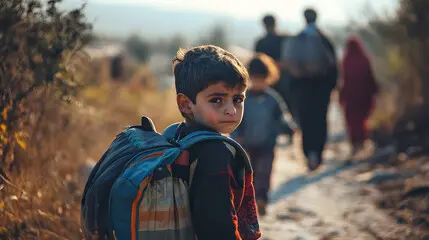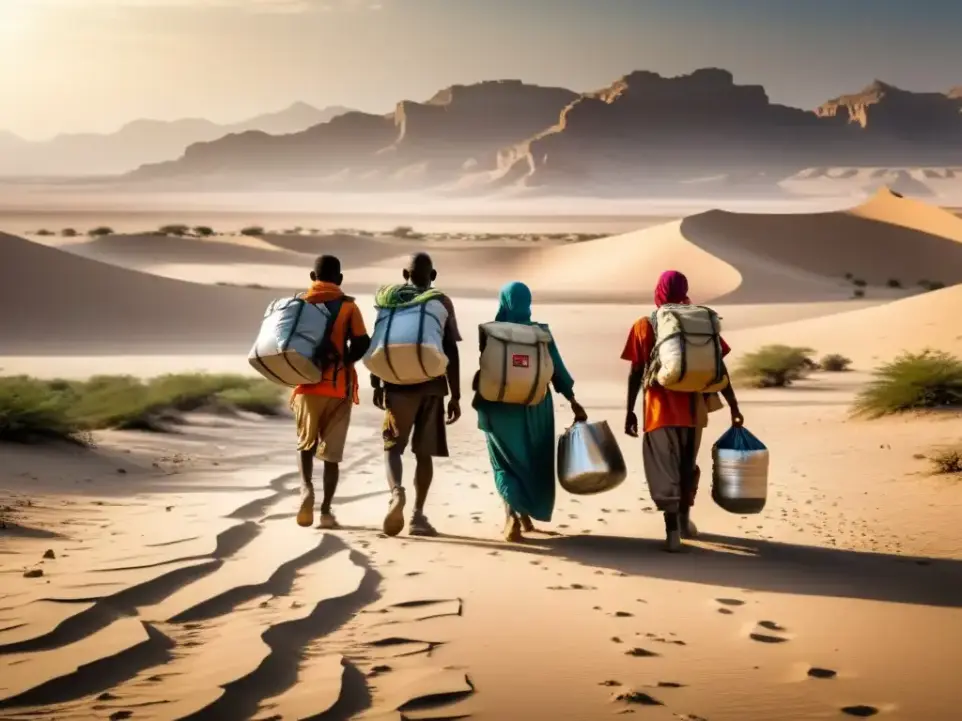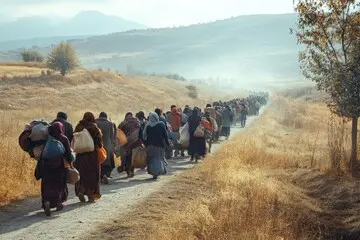Climate Migration: Unraveling the Causes and Consequences for Displaced Communities
In our theme "Climate Migration: Unraveling the Causes and Consequences for Displaced Communities," we explore in depth the intersection between climate migration and human rights. Delve into this fascinating topic impacting communities around the world, discovering the implications and challenges they face. Prepare for an informative journey that will leave you wanting to learn more!






Introducción
Climate migration refers to the displacement of people due to environmental phenomena related to climate change, such as droughts, floods, hurricanes, and rising sea levels. This type of migration can be internal or cross-border, and its impact on human rights is significant.
The relevance of climate migration to human rights lies in the fact that displaced people face a range of challenges, including the loss of housing, livelihoods, and access to basic services. Furthermore, they may face discrimination and rights violations during their displacement and settlement in new areas.
It is crucial to understand that climate migration is not only an environmental phenomenon but also a human rights issue that requires comprehensive and supportive responses at the national and international levels.
Vulnerable communities, especially those that directly depend on natural resources for their livelihoods, are disproportionately affected by climate change. Droughts, floods, desertification, and other climate-related phenomena can exacerbate food insecurity, unemployment, and poverty in these communities.
Furthermore, climate change can lead to environmental degradation, which in turn affects the physical and mental health of people living in these communities. Crop failures, water scarcity, and the destruction of infrastructure are just some of the concrete consequences that negatively impact the lives of these people.
It is critical to recognize that these communities are the least responsible for climate change, yet are often the most affected. Therefore, addressing the impact of climate change on vulnerable communities is a matter of justice and equity.
Addressing climate migration and the impact of climate change on vulnerable communities from a human rights perspective is essential to ensure that the rights of all affected people are respected, protected, and fulfilled. This entails adopting inclusive approaches that consider the needs and concerns of climate-displaced people and vulnerable communities.
A human rights perspective also emphasizes the responsibility of governments, international institutions, and society as a whole to address these issues, promoting the active participation of affected communities in decision-making that impacts their lives.
Considering climate migration and the impact of climate change from a human rights perspective promotes a more just, equitable, and sustainable approach to addressing these global challenges.
Causes of climate migration and its impact on human rights
Climate migration is driven by several factors, including extreme climate variations that affect communities' ability to sustain themselves in their territories. Climate events such as hurricanes, droughts, and floods can destroy crops, damage infrastructure, and endanger people's lives. As a result, many communities are forced to abandon their homes in search of safer and more sustainable living conditions.
These extreme climate variations not only cause material damage but also generate food insecurity, water scarcity, and loss of livelihoods. This directly impacts the human rights of these communities, as they are deprived of the right to an adequate standard of living, food, water, and decent work, among others. Climate migration, therefore, not only represents physical displacement but also a violation of the fundamental rights of those affected.
It is essential to understand that climate migration is not simply an environmental phenomenon but is closely linked to the protection of human rights. Addressing this issue requires ensuring the safety, dignity, and well-being of displaced people, as well as implementing measures to mitigate the impacts of climate change and prevent future forced displacement.
The deterioration of natural resources, such as deforestation, soil erosion, and pollution, contributes significantly to climate migration. Communities that directly depend on land and natural resources are particularly affected by environmental degradation, forcing them to seek new forms of livelihood.
The loss of natural resources disproportionately impacts the most vulnerable communities, who often lack access to fertile land, clean water, and other essential resources. This not only leads to forced migration but can also exacerbate the poverty and marginalization of these communities, perpetuating a cycle of vulnerability and exclusion.
From a human rights perspective, the deterioration of natural resources represents a violation of the right to a healthy and balanced environment, as well as of peoples' right to self-determination. Migration resulting from these adverse conditions jeopardizes other fundamental rights, such as the right to housing, health, and participation in decision-making that affects the community.
To address this challenge, it is crucial to implement environmental conservation, ecosystem restoration, and sustainable development strategies that protect natural resources and guarantee the rights of affected communities. Likewise, inclusive approaches must be promoted that respect and value the traditional knowledge of local communities, recognizing their crucial role in preserving the environment and mitigating the impacts of climate change.
Climate change not only causes natural disasters but can also trigger conflicts and tensions that result in massive population displacement. Scarcity of resources, such as water and arable land, can generate territorial disputes and exacerbate existing tensions between communities, exacerbating pre-existing conflicts or giving rise to new ones.
These climate change-related conflicts can have devastating impacts on human rights, as communities are exposed to violence, insecurity, and the loss of their livelihoods. Furthermore, forced displacement as a result of these conflicts hinders access to basic services, child protection, and social integration for affected people.
It is essential to address the relationship between climate change, conflict, and displacement from a human rights perspective, recognizing the importance of preventing and resolving conflicts, protecting displaced people, and addressing the underlying causes of instability. This requires comprehensive approaches that promote justice, equity, and the meaningful participation of affected communities in decision-making that affects their lives and their environment.
Climate migration poses significant challenges for the protection of human rights, as displaced communities face a number of obstacles in their search for safety and stability. One of the main challenges lies in the legal recognition of climate-displaced persons, as many jurisdictions lack robust legal frameworks to address this form of migration. This can leave displaced persons without adequate legal protection, increasing their vulnerability to exploitation and discrimination.
Furthermore, climate migration can cause tensions in receiving communities, which in turn can lead to social conflict and violations of displaced persons' rights. Competition for limited resources, such as employment and housing, can exacerbate pre-existing tensions and give rise to discrimination and xenophobia toward newcomers. This poses the challenge of protecting the human rights of displaced persons while addressing the need for integration and social cohesion in receiving communities.
Another crucial challenge is the issue of climate justice, as displaced communities often come from regions that have contributed minimally to climate change but disproportionately bear its impacts. Ensuring the protection of human rights in this context requires addressing the underlying causes of climate change and ensuring that displaced communities have access to resources and support to rebuild their lives in safer and more sustainable environments.
Consequences of climate migration on displaced communities
Climate migration has a significant impact on food security and access to basic resources for displaced communities. Changes in weather patterns can affect agricultural production, which in turn can lead to food shortages and rising prices. Communities dependent on agriculture and fishing are particularly affected, as their livelihoods become increasingly precarious due to environmental degradation. Lack of access to clean water and fertile land further exacerbates the situation, forcing communities to move in search of more favorable conditions for their survival.
Furthermore, forced displacement often leads to the loss of employment and social support networks, further hindering access to basic resources. Displaced communities face significant challenges in meeting their most basic needs, jeopardizing their food security and overall well-being.
Understanding and addressing these complex interrelationships between climate migration, food security, and access to basic resources is critical to ensuring the protection of displaced people's human rights.
Climate migration poses significant adaptation and relocation challenges for affected communities. Sudden changes in environmental conditions, such as floods, droughts, and storms, force communities to abandon their homes and seek refuge in safer areas. However, relocation is not always a viable option, as many communities face economic, social, and political obstacles to settling in new locations.
Furthermore, adapting to unfamiliar environments and losing their connection to land and cultural traditions pose significant emotional and psychological challenges for displaced communities. The lack of adequate infrastructure, basic services, and economic opportunities in relocation areas can further exacerbate their vulnerability.
The planning and implementation of effective adaptation and relocation strategies are critical to mitigating the negative impacts of climate migration on affected communities. This requires collaboration between governments, non-governmental organizations, and the international community to ensure that the human rights of displaced persons are respected and their needs are comprehensively addressed.
Climate migration poses unique challenges for the protection of the rights of displaced persons. Existing laws and mechanisms are often not designed to address the complex realities of forced migration due to climate change. This can leave displaced persons in a precarious legal situation, without access to the protection and resources needed to rebuild their lives.
It is critical that the legal status of people displaced by climate change be recognized and that specific legal frameworks and policies be developed to address their needs. This includes ensuring access to basic services, such as healthcare and education, as well as protection from exploitation and discrimination.
Furthermore, it is crucial to establish effective mechanisms for the participation of displaced communities in decision-making processes that affect their lives. This may include creating inclusive governance structures that allow affected communities to contribute their experience and knowledge to proposed solutions.
Protecting the rights of people displaced by climate change requires a comprehensive approach that addresses both their immediate needs and their long-term rights. This requires a firm commitment from the international community to ensure that no one is left behind amid the evolving climate crisis.
Actions and policies to address climate migration from a human rights perspective
Climate migration poses significant challenges to the international legal framework due to its transnational and often forced nature. While there is no specific treaty exclusively addressing climate migration, the principles and norms of international human rights law provide a relevant framework for the protection of people displaced by climate change.
The United Nations Framework Convention on Climate Change (UNFCCC) recognizes the importance of considering human rights in all climate-related activities. Furthermore, international instruments such as the International Covenant on Civil and Political Rights and the International Covenant on Economic, Social and Cultural Rights, as well as the Geneva Convention relating to the Status of Refugees, are critical for addressing climate migration from a human rights perspective.
The effective application of these legal frameworks in cases of climate migration requires a holistic understanding of the causes and consequences of displacement, as well as recognition of the vulnerability of affected people. International cooperation and solidarity are essential elements to ensure the protection and respect for the human rights of communities displaced by climate change.
Faced with the growing impact of climate migration, various governmental and non-governmental organizations have launched initiatives aimed at providing protection and assistance to communities displaced by climate change. These initiatives range from resettlement programs to strengthening the resilience of vulnerable communities.
The United Nations Refugee Agency (UNHCR), for example, has been working closely with governments and other organizations to address the specific challenges faced by people displaced by climate-related disasters. Funds and financial mechanisms have also been established to support climate change adaptation and the protection of the human rights of affected communities.
It is critical that these initiatives not only focus on immediate assistance, but also address the underlying causes of climate migration and promote sustainable solutions that respect the human rights of displaced people. Collaboration between international, state, and local actors is crucial to ensure that these initiatives are effective and respond to the real needs of communities displaced by climate change.
The meaningful participation of communities affected by climate migration in decision-making and solution-finding is a fundamental principle of human rights. Recognizing the agency of displaced persons and ensuring their active participation in the formulation and implementation of policies and programs is essential to effectively addressing the challenges associated with climate migration.
Including the voices of affected communities can contribute to the identification of contextualized solutions that respect their culture, knowledge, and experiences. Likewise, promoting inclusive participation can help prevent the marginalization and exclusion of displaced persons, thus strengthening the protection of their human rights in the context of climate migration.
Participation and consultation mechanisms must be designed to ensure the representativeness and autonomy of displaced communities, allowing them to actively contribute to the search for sustainable, human rights-centered solutions. The inclusion of affected communities in decision-making processes is critical to ensuring that responses to climate migration are effective, fair, and respectful of human rights.
Impact of climate migration on the global human rights agenda
Climate migration has taken on unprecedented relevance for the protection of human rights at the international level. As the effects of climate change intensify, increasing numbers of people are forced to leave their homes due to natural disasters, environmental degradation, and extreme weather events. This situation poses significant challenges for the international community in terms of human rights protection, as displaced communities face serious risks, including a lack of security, loss of livelihoods, and vulnerability to exploitation and abuse.
Climate migration not only affects individuals but also poses challenges to social and political stability, as well as global security. Therefore, the inclusion of climate migration in the human rights agenda is crucial to address these complex interactions between climate change, migration, and the protection of human rights globally.
A comprehensive approach is needed that recognizes climate migration as a multidimensional phenomenon requiring coordinated responses at the national and international levels. Protecting the human rights of people displaced by climate change must be considered a priority in both national policies and international agreements, in order to ensure that these people receive the necessary assistance and protection.
Conclusions
Climate migration and human rights are intrinsically interconnected, as climate change can exacerbate human rights violations and lead to mass population movements. Vulnerable communities, which often have the least capacity to adapt to the impacts of climate change, are the most affected. From the loss of homes due to natural disasters to the scarcity of resources such as water and land for agriculture, climate change threatens the full enjoyment of human rights by these communities.
It is crucial to understand that climate migration is not only an environmental phenomenon but also has profound human rights implications. The international community must address this crisis with a comprehensive approach that recognizes and protects the rights of climate-displaced people, ensuring their safety, well-being, and dignity.
The United Nations Framework Convention on Climate Change (UNFCCC) and other human rights instruments must work together to address climate migration from a perspective that protects the fundamental rights of displaced people.
Faced with the challenge of climate migration, it is essential to implement comprehensive measures that address the needs of communities displaced by climate change. These measures must be based on a human rights approach that guarantees the protection, assistance, and active participation of climate-displaced people in decision-making that affects their lives.
International cooperation is essential to developing effective responses to climate migration, including the creation of legal frameworks and policies that protect the rights of these communities. Furthermore, it is crucial to guarantee access to basic resources and services, as well as promoting the resilience and adaptation of vulnerable communities to climate change.
Ultimately, addressing climate migration from a human rights perspective is not only a matter of justice, but also a necessary measure to build a sustainable and inclusive future for all people, regardless of their place of origin or migration status.
